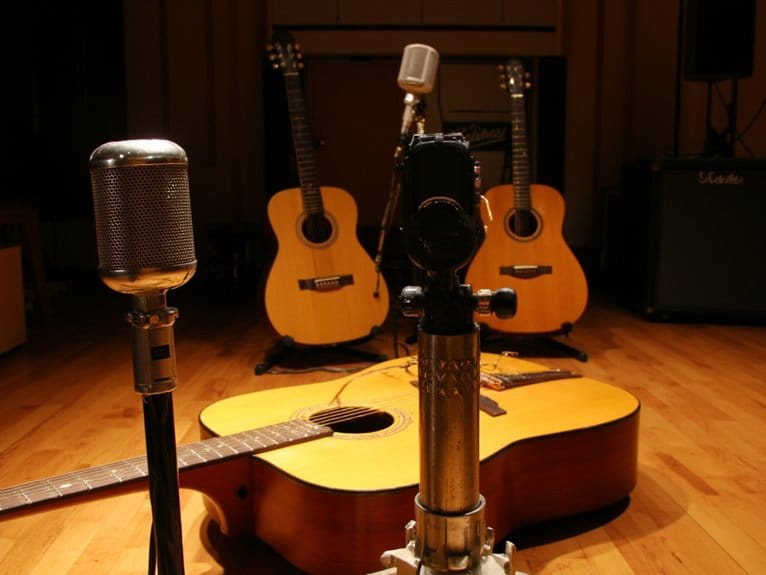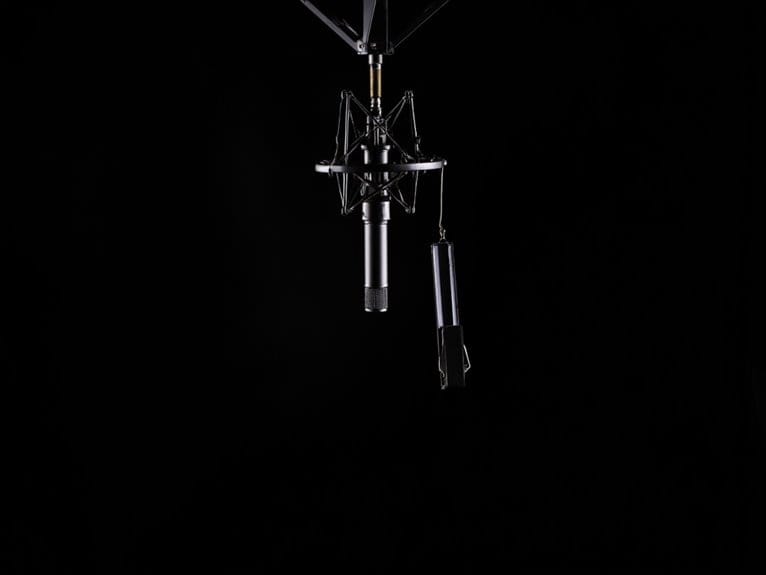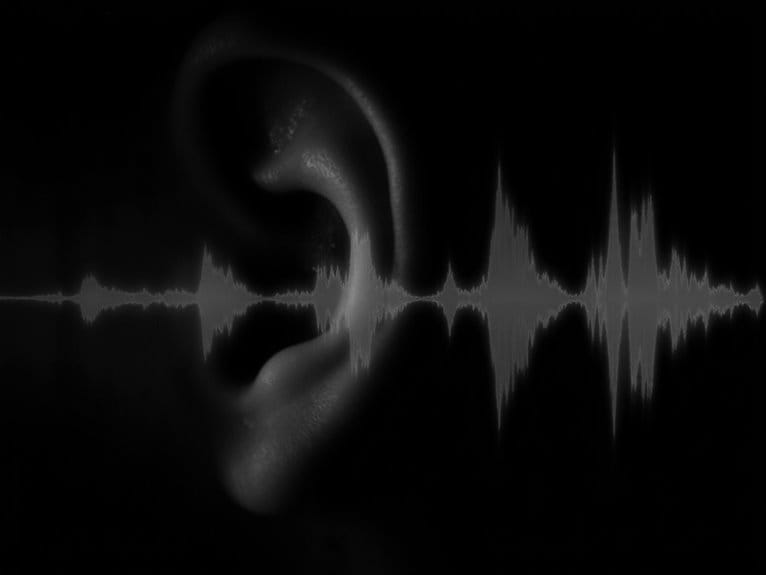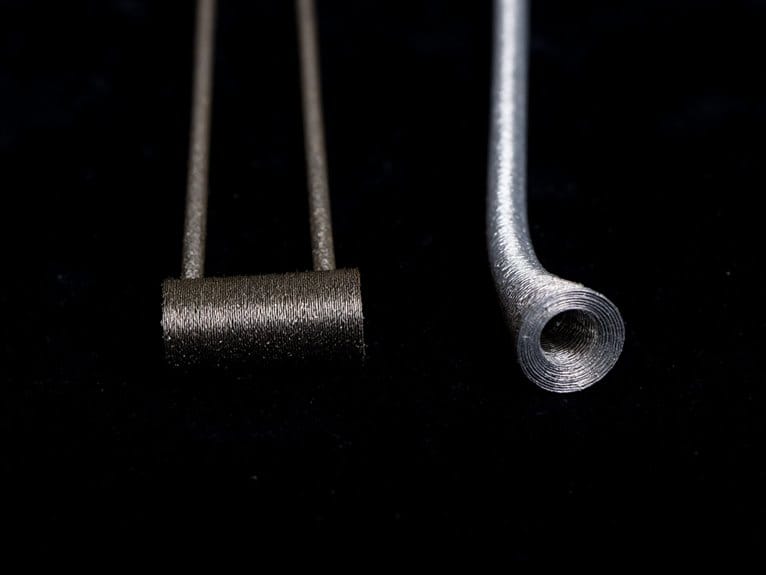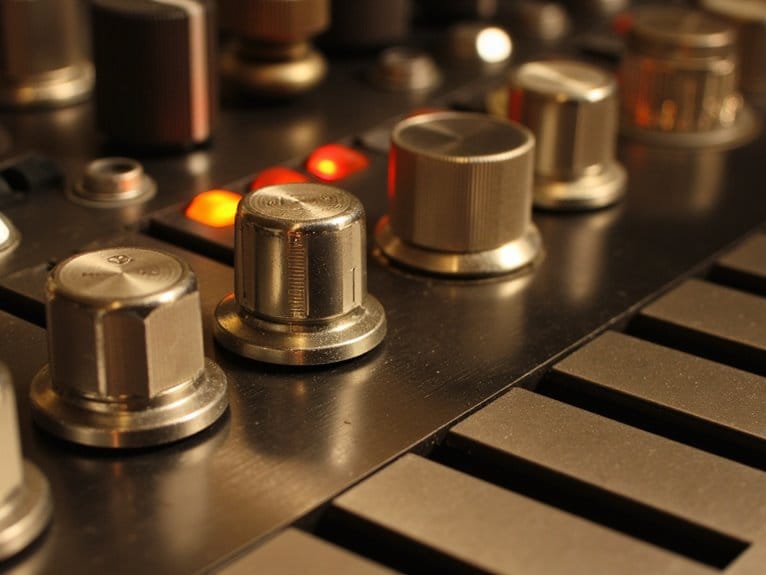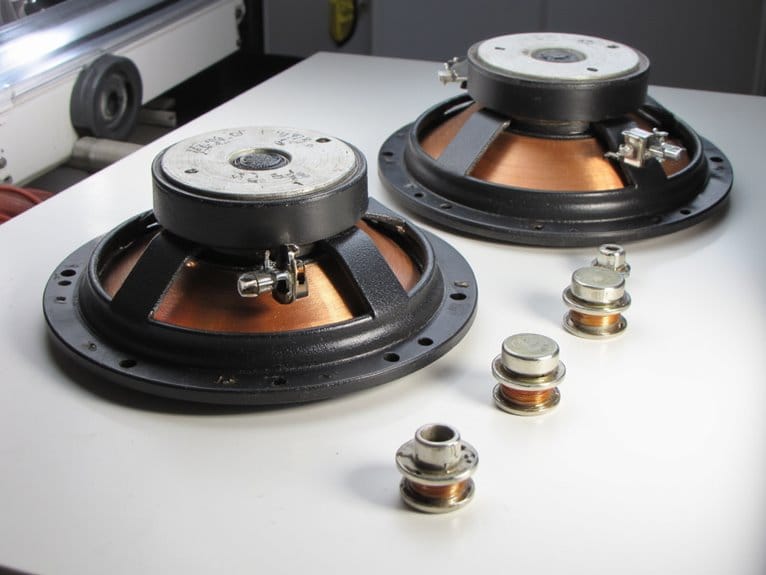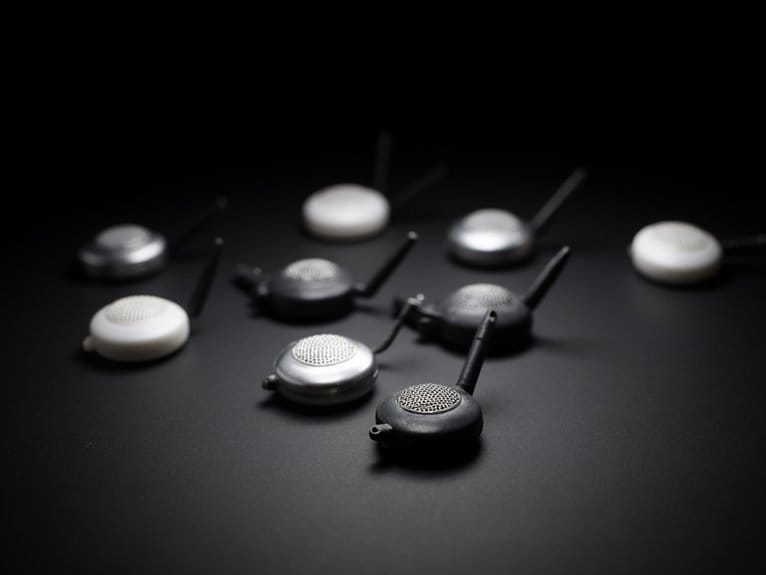Understanding Phase Issues With Multiple Microphones
When you’re recording with multiple microphones, phase issues occur because sound waves arrive at each mic at slightly different times, creating timing discrepancies that cause frequency cancellation and that distinctive thin, hollow sound. You’ll notice symptoms like reduced stereo width, fluttering audio, and dead spots where certain frequencies vanish completely. The 3:1 rule helps prevent these problems by maintaining proper distance ratios between microphones, while coincident techniques like XY positioning align phase relationships naturally. Understanding these fundamentals opens the door to more sophisticated recording strategies.
We are supported by our audience. When you purchase through links on our site, we may earn an affiliate commission, at no extra cost for you. Learn more.
Notable Insights
- Distance differences between microphones create timing discrepancies that lead to phase cancellation and comb filtering effects.
- The 3:1 rule ensures one microphone is three times closer to its source than competing mics.
- Phase problems manifest as thin sound, reduced stereo width, frequency dead spots, and distinctive audio fluttering.
- Visual waveform analysis and correlation meters help identify phase misalignments between multiple microphone tracks effectively.
- Polarity inversion, manual timing adjustments, and phase alignment plugins correct problematic phase relationships in recordings.
What Causes Phase Problems in Multi-Microphone Setups
When you’re setting up multiple microphones to capture a single source, you’re fundamentally creating a complex web of sound wave interactions that can quickly turn your pristine recording into a hollow, thin mess if you don’t understand the underlying physics at play.
The primary culprit is distance differences between your microphones, which creates timing discrepancies as sound waves travel at a constant 343 meters per second through air. Poor microphone alignment compounds these issues, especially when you’re dealing with directional mics that have different polar patterns picking up sound from various angles.
Sound propagation becomes increasingly problematic in reflective environments, where acoustic reflections create additional phase relationships that can cancel out frequencies, leaving you with that dreaded comb filtering effect that makes everything sound like it’s coming through a tunnel. These issues become particularly challenging with drum recordings, where multiple microphones are essential but create the highest risk for phase cancellation between different elements of the kit.
Even when engineers believe they’ve achieved proper mic placement, slight movements of the sound source can completely disrupt phase coherence, making it nearly impossible to maintain consistent results throughout a recording session.
Common Recording Scenarios Where Phase Issues Occur σε
Now that you understand the physics behind phase problems, let’s examine the real-world recording scenarios where these issues most commonly rear their ugly heads.
I’ve learned the hard way that knowing the theory doesn’t automatically prevent you from walking straight into these acoustic landmines.
These common recording scenarios will test your phase awareness: stereo miking acoustic guitars creates timing conflicts between sound hole and neck microphones, while multi-miking drum sets generates phase discrepancies between overhead and individual mics.
Phase problems lurk in every multi-mic setup, turning your carefully planned recording session into an acoustic nightmare.
Piano recordings amplify these problems due to complex reflections reaching multiple microphones at different times, and combining DI signals with microphone captures on bass or electric guitars introduces alignment challenges. When phase cancellation occurs between these signals, the result can be a dramatically weakened or hollow sound that undermines your entire recording.
These phase issue examples demonstrate how seemingly straightforward recording techniques can sabotage your mix when microphones aren’t positioned with careful consideration of sound wave arrival times. Classical guitar recordings particularly suffer when using dual-pickup systems that combine microphone and piezo elements without proper phase alignment. Layering samples without properly aligned waveforms can similarly weaken your mix, particularly affecting low frequencies where phase discrepancies have the most destructive impact.
Essential Recording Techniques to Prevent Phase Conflicts
After years of fixing phase disasters in post-production, I’ve discovered that prevention beats correction every single time. The techniques I’m about to share will save you countless hours of frustration while dramatically improving your recordings’ clarity and punch.
The 3:1 rule remains my go-to approach for mic distance positioning, placing your second microphone three times farther from the first mic than the distance between the first mic and your sound source. You’ll want to avoid equidistant placement configurations, which create simultaneous wave arrivals that’ll kill your sound capture faster than you can say “comb filtering.” For drum overhead recording, maintain equal distances from snare and kick drums to prevent phase issues that can compromise your stereo imaging. Cardioid patterns help minimize interference between microphones while maintaining proper directional pickup characteristics.
I consistently use coincident techniques like XY or MS stereo configurations because they inherently align phase relationships while maintaining excellent mono compatibility for professional results. During recording sessions, I always monitor in mono to immediately catch any phase conflicts before they become permanent problems in the mix. Remember that correct polarity ensures your speakers move in sync with the microphones capturing sound, preventing destructive interference that can ruin your multi-track recordings.
How to Identify and Diagnose Phase Problems
When phase problems rear their ugly head in your recordings, you’ll need reliable detection methods that combine both your ears and your eyes to pinpoint these sneaky audio gremlins.
Visual waveform analysis gives you the surgical precision to spot timing misalignments between tracks, while audio monitoring techniques help you hear the telltale signs of phase cancellation that might otherwise slip past your notice.
I’ve found that using both approaches together creates a thorough diagnostic toolkit that’ll save you hours of frustration, especially when dealing with complex multi-microphone setups where phase relationships can get messy fast. The comb filtering effects created by phase cancellation will produce distinctive patterns that make certain frequencies ring out while others seem to disappear entirely from your mix.
Your software’s correlation meters provide an invaluable visual reference that displays the phase relationship between channels in real-time, making detection of phase issues much more straightforward than relying on ears alone.
Visual Waveform Analysis Methods
Since phase problems can wreak havoc on your recordings in ways that aren’t always obvious to your ears alone, I’ve found that visual waveform analysis becomes your most reliable diagnostic tool for identifying these sneaky audio gremlins.
Through careful waveform visualization, you’ll spot telltale patterns that reveal when your microphones are working against each other rather than together, creating those frustrating frequency cancellations that thin out your sound.
Here’s what I look for during phase alignment analysis:
- Opposite waveform directions – When tracks move in contradictory patterns, your heart sinks knowing precious frequencies are disappearing.
- Misaligned peaks – Those offset timing patterns that make you question every microphone placement decision you’ve made.
- Asymmetrical waveform shapes – The visual chaos that confirms your suspicions about problematic delays.
- Crossover intersections – Those crossing points where phase relationships reveal their destructive secrets.
Beyond visual analysis, you’ll often notice symptoms like a thin sound quality, reduced stereo width that pushes your mix toward mono, or that distinctive fluttering audio characteristic that immediately signals phase complications in your recording chain. These phase cancellations frequently create noticeable dead spots where certain frequencies completely vanish from your mix.
Audio Monitoring Techniques
While visual waveform analysis gives you the roadmap to phase problems, your ears remain the ultimate judge of whether those theoretical cancellations actually translate into audible issues that’ll sabotage your mix.
Your headphone monitoring might mask phase problems that become glaringly obvious through studio monitors, since headphones isolate left and right channels completely. I’ve learned that switching between headphones and speakers reveals different aspects of phase relationships, particularly when checking how your mix translates across playback systems.
Your speaker configuration plays a vital role in detecting phase anomalies, especially when you’re A/B comparing different mic combinations or checking mono compatibility.
Testing your mix in mono will expose phase cancellations that hide in stereo, while panning individual tracks helps you isolate problematic frequency interactions between multiple microphones.
Corrective Methods for Fixing Phase Issues During Mixing
Once you’ve identified phase problems between your microphones, you’ll need to apply specific corrective techniques that address the root cause of the cancellation, whether it’s polarity issues, timing misalignment, or frequency conflicts.
The three primary methods I rely on during mixing include polarity inversion techniques for quick 180-degree phase fixes, manual timing adjustments that involve nudging tracks to align waveform peaks, and strategic EQ filtering to minimize frequency-specific cancellations.
These corrective approaches, when applied systematically and monitored through both visual meters and critical listening, can restore the clarity, punch, and spatial coherence that phase issues steal from your mix.
Polarity Inversion Techniques
When I encounter phase cancellation issues during mixing that rob my tracks of their low-end punch and create that hollow, lifeless sound we all dread, polarity inversion becomes one of my most reliable corrective tools.
These polarity techniques fundamentally flip your audio signal by 180 degrees, reversing the positive and negative peaks to restore audio coherence when multiple microphones are creating destructive interference.
Here’s what makes polarity inversion so effective:
- Instantly restores lost low-end frequencies that phase cancellation steals from your mix
- Transforms hollow, weak recordings into full, resonant tracks with proper depth
- Eliminates that frustrating “something’s missing” feeling when your mix lacks punch
- Works seamlessly with your DAW’s built-in tools, requiring no additional plugins or complex processing
Manual Timing Adjustments
Beyond polarity flips, manual timing adjustments offer the surgical precision needed when phase issues stem from microphone placement distance rather than simple signal inversion. When I’m dealing with drums recorded with multiple mics, waveform nudging becomes essential for achieving coherent phase relationships between close mics and overheads.
| Method | Best Use Case | Precision Level |
|---|---|---|
| Visual Waveform Alignment | Snare/kick transients | Sample-accurate |
| Delay Plugin Adjustments | Distance-based timing | Millisecond control |
| Timeline Dragging | Quick rough corrections | Moderate precision |
| Correlation Meter Monitoring | Real-time feedback | Quantitative analysis |
| Polarity Inversion Testing | Finding null points | Phase relationship |
Start with polarity checks, then use delay plugins for distance-based corrections, supplementing with visual alignment on transients while monitoring correlation meters for best phase coherence.
EQ and Filtering
Three fundamental approaches define how EQ and filtering can rescue phase-compromised recordings, though I’ll admit that reaching for EQ to fix phase issues often feels like putting a band-aid on a broken bone.
Your equalization strategies should focus on surgical cuts using narrow Q values to target specific comb filter frequencies, while filter types determine whether you’re dealing with latency considerations from linear phase processors or sound coloration from analog vs. digital minimum-phase designs.
Here’s what you’re really fighting against:
- Frequency emphasis decisions that can make phase cancellations devastatingly obvious
- Phase manipulation artifacts that turn your mix into an unstable mess
- Dynamic adjustments that shift problems rather than solving them
- Spectral matching attempts that highlight every timing inconsistency
Strategic filtering narrows frequency overlap between microphones, though re-recording remains your most effective solution.
Advanced Stereo Microphone Techniques for Phase Coherence
When you’re ready to elevate your recording game beyond basic microphone placement, mastering advanced stereo techniques becomes essential for maintaining phase coherence while capturing that professional, three-dimensional soundscape that separates amateur recordings from studio-quality work.
The X Y technique advantages include exceptional phase coherence through close microphone positioning at 90-degree angles, ensuring mono compatibility without sacrificing stereo imaging.
Meanwhile, Mid Side flexibility offers unparalleled control, allowing you to adjust stereo width during post-production while maintaining perfect phase relationships.
For dynamic microphones with low output like the Shure SM7B, your audio interface must deliver at least +60 dB of clean gain to ensure optimal performance in stereo recording configurations.
Professional USB microphones like the RØDE PodMic USB now offer dual connectivity options that simplify stereo recording setups while maintaining broadcast-quality audio standards.
Here are four game-changing benefits you’ll experience:
- Crystal-clear mono compatibility that prevents your mix from falling apart on single speakers
- Adjustable stereo spread that adapts to any listening environment
- Professional-grade phase coherence that eliminates those frustrating cancellation issues
- Enhanced spatial dimension that makes listeners feel immersed in your recordings
Now that you’ve mastered these advanced stereo techniques, the real challenge becomes maintaining that phase coherence when you’re dealing with multiple microphones, complex room acoustics, and the inevitable curveballs that live recording sessions throw your way.
Different microphone types respond uniquely to recording environments, so you’ll need to position them at equal distances from your source, follow the 3-to-1 rule religiously, and avoid those pesky reflective surfaces that’ll ruin your day.
I’ve learned that performing polarity checks before rolling tape saves countless headaches later, while phase correlation meters become your best friend for real-time monitoring.
Smart pre-recording prep, including test tracks and visual phase tools, prevents most issues before they start. Room acoustics significantly impact recording quality and can introduce phase problems when sound waves reflect off untreated surfaces in your recording space.
Cardioid polar patterns help isolate instruments from unwanted bleed between microphones, which becomes especially critical when managing phase relationships in multi-mic setups.
Frequently Asked Questions
Can Phase Issues Occur Even When Using Identical Microphones and Preamps?
Yes, you’ll definitely encounter phase issues even with identical microphones and preamps, since microphone placement creates the real problem.
When your sound source reaches each mic at slightly different times due to distance variations, you’re getting phase shifts regardless of matching hardware.
I’ve seen phase cancellation from just millimeters of difference in positioning, proving that acoustic timing matters more than electronic matching.
How Do Acoustic Room Characteristics Affect Phase Relationships Between Multiple Microphones?
Your room’s acoustic reflections create timing differences that’ll mess with phase relationships between microphones, even when they’re positioned identically.
Hard surfaces bounce sound waves back at varying delays, causing some frequencies to cancel while others reinforce.
Strategic microphone placement becomes essential since you’re dealing with direct sound plus reflected copies arriving milliseconds later, which translates to phase shifts that can dramatically alter your recording’s frequency response.
Are There Specific Frequency Ranges More Susceptible to Phase Cancellation Than Others?
Yes, you’ll find that low frequencies are most vulnerable to phase cancellation because their long wavelengths make small timing differences between mics catastrophic for your frequency response.
Mid frequencies experience partial cancellation that creates thinness, while high frequencies suffer from comb-filtering effects that disrupt phase coherence.
I’ve noticed bass and kick drums lose power dramatically, making proper mic placement essential for maintaining fullness.
Can Phase Problems Be Completely Avoided in Live Recording Situations?
You can’t completely eliminate phase problems in live recording situations, though effective live recording techniques greatly minimize them.
I’ve found that combining proper mic placement, the 3:1 rule, and real-time monitoring during sound check creates solid phase alignment strategies.
However, room acoustics, performer movement, and ambient reflections introduce variables you can’t control, so you’ll need to manage rather than eliminate these issues entirely.
On a final note
You’ve now got the essential toolkit for conquering phase issues in your multi-microphone recordings. While I’ll admit these concepts can feel overwhelming at first, implementing proper microphone placement, monitoring your phase meters regularly, and trusting your ears will become second nature with practice. Remember, phase coherence isn’t just technical perfectionism—it’s the difference between muddy, weak recordings and punchy, professional-sounding mixes that translate well across all playback systems.

